The dynamic performer, actor and director Euripides Laskaridis is stirring up the Greek art scene.
Text: Florian Gaité
Text: Florian Gaité
With ‘ridicule’ and ‘transformation’ as his guiding principles, the Greek artist Euripides Laskaridis has conceived a performance where a pair of Titans, probably prefiguring the humanity to come, mess around in their eternal cave. With its air of a disillusioned carnival, the piece takes advantage of the critical power of the odd and the caricatural to present a visual fable whose meaning is, deliberately left open-ended.
The movie and theater actor and dance performer Euripides Laskaridis, who has worked with Robert Wilson and Dimitris Papaioannou, is also a stage and film director. He has been an inveterate shape-shifter and explorer of multiple paths since first studying architecture and later switching to theater arts at Brooklyn College in New York, creating a universe integrating burlesque, movies, circus and theater of the absurd. A standout figure in the Greek new performance scene, associated with Aerowaves new dance hub and winner of a Pina Bausch fellowship in 2016, Laskaridis is known for his controlled eccentricity, acute sense of dramaturgy and visual inventiveness. His company, OSMOSIS, lives up to its paradoxical name, referring both to a sudden thrust and the reciprocal influence of two opposed elements. Thus his performance projects produce complex and fragmentary narratives that freely mix different genres and registers so as to open the field of possible interpretations as widely as possible. In “TITANS” two bored protodivine Todd Browning-esque freaks mess around in a surpralunar microcosm that is both prequel and sequel to the historical world. Mirrors of humanity or perhaps its foils, they play the role of figures deeply disillusioned by existence, responding to the derisory quality of their condition with a purgative loud laugh.

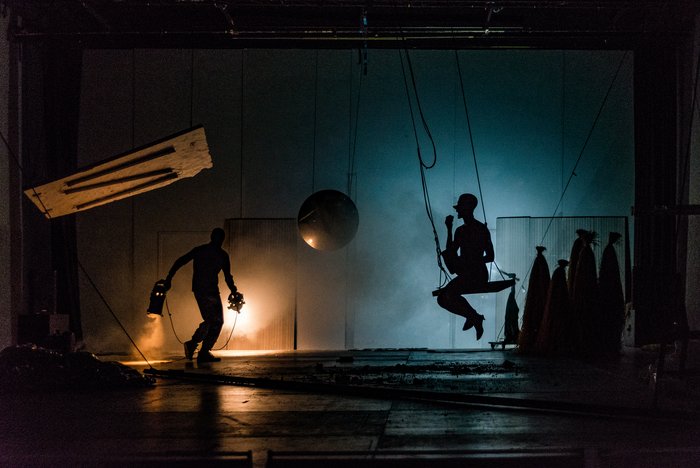
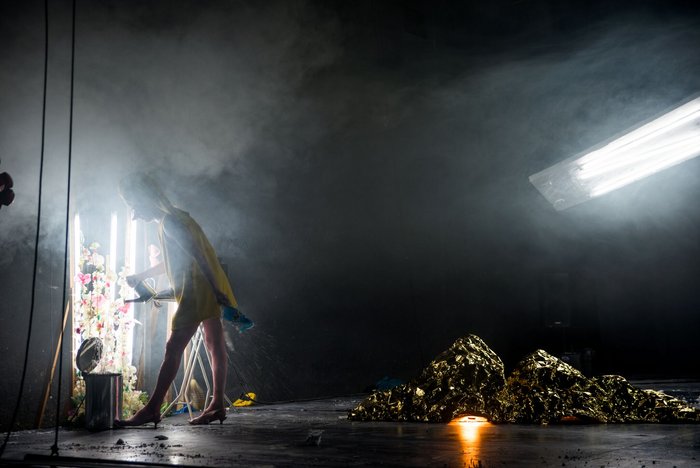
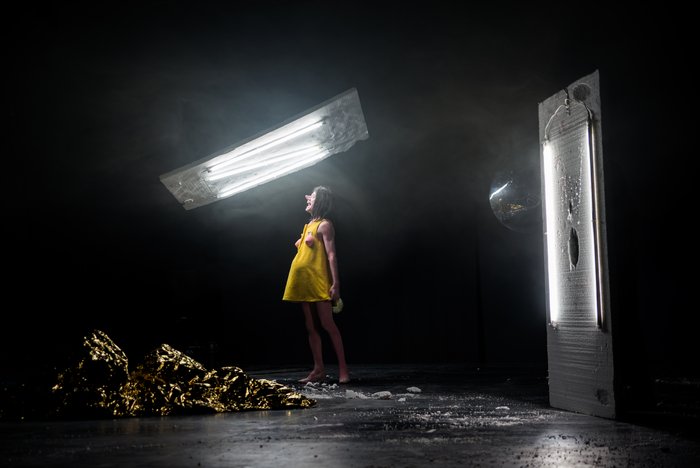
In line with Laskaridis' earlier work “Relic”, “TITANS” features two grotesquely made-up creatures of no particular gender or ethnicity. The central character, pink-skinned, hydrocephalic, with a protuberant nose and visibly pregnant (or simply plump), is accompanied by a subhuman shadowy assistant. Objects of curiosity, their appearance is a real attention-getter, since in Laskaridis' work the ‘seduction bonus’ (as Freud would say) is primarily visual, above all an ensemble of artifices meant to attract audiences by pandering to their taste for the incongruous, bizarre and motley. “TITANS” borrows from popular entertainment practices (circus, vaudeville and cabaret) in which cross-dressing plays a central role. The set design unabashedly parallels this resort to spectacle, even though here it is constrained to a DIY minimalism occasionally recalling ‘Arte Povera’. The action takes place in a claustrophobic space that might seem domestic if the hanging props, otherwise empty stage and darkness did not lend this banality a more celestial dimension, like a deconstructed planetary mobile or the ruins of a paradise lost. Spare and constantly changing, it represents above all a site of plasticity revealing the malleability of the characters' identities.
The queer freak aesthetics here, previously seen in the performance “Venus”and “Relic”, enable an interrogation of our relationship to the strange and our acceptance of difference, and brings social performance into the theater realm. But unlike Leigh Bowery, Klaus Nomi, Divine, or Christeene, who produce the incommensurable and irreducible, through these figures Laskaridis seeks to shine a spotlight on the dimension of the ridiculous lurking within all of us. He invites us to see ourselves as caricatures, failed actors in a life determined by others. In “Quirks” a series of photo selfportraits, he uses disguises to emphasize the power of social constructions and the enormous degree to which we incorporate them into our persona. At the same time, as with performers like South-African Steven Cohen, this use of drag makes it possible to impart a sublimity to the monstrosity of the protagonists by means of a free-form reconfiguration of their symbols of identity.
For Laskaridis, the figure of Greek mythological monsters is not so much an appropriation of folklore, a recycling of a traditional narrative, as a symbolic evocation of archaic human qualities. From Aristophanes' ancient comedies to the myths revisited in “Dearest Welcoming Lemnos”, and of course the absurd pantheon of “Venus”and “Relic”, in his work this heritage is made to stand for a lost origin and thus serves as a counterpoint that allows us sense the distance between the ideal world and reality, the superego of a civilization and its actuality.
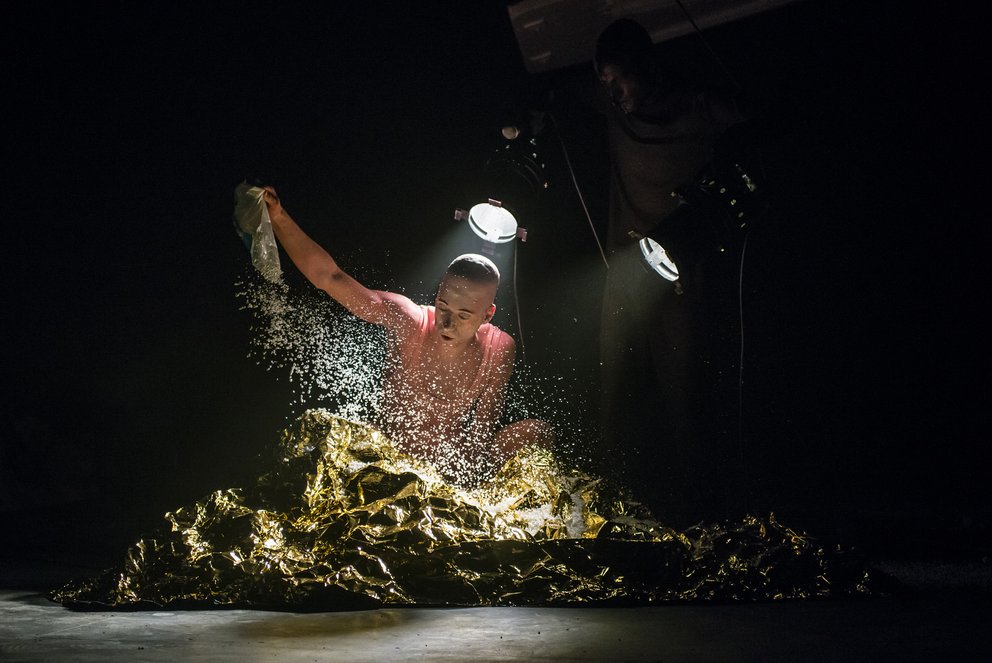
As mirrors of humanity, with its failures and uncertainties, the titans are anti-heroes, primitive gods that remind humanity of its original idiocy. Their eccentric display constitutes a way to make manifest a primitive and prerational state of the world, as well as a return to a unconscious state, with all that implies in terms of indeterminacy, irrationality and spontaneity. From the psychological microcosm to the stellar macrocosm, Laskaridis constructs an elastic metaphorical landscape where we are invited to situate ourselves as we like. Although Laskaridis founded his company in 2009, in the context of the Greek debt crisis when he refused to allow the performance of “Syntagma” because of the turn taken by political events, “TITANS” cannot be interpreted as an allegory of the turmoil the country has experienced since 2008. Resolutely atemporal and unrooted, its aim is to reconnect with the tragedy of our original condition and, not to reflect today's world.
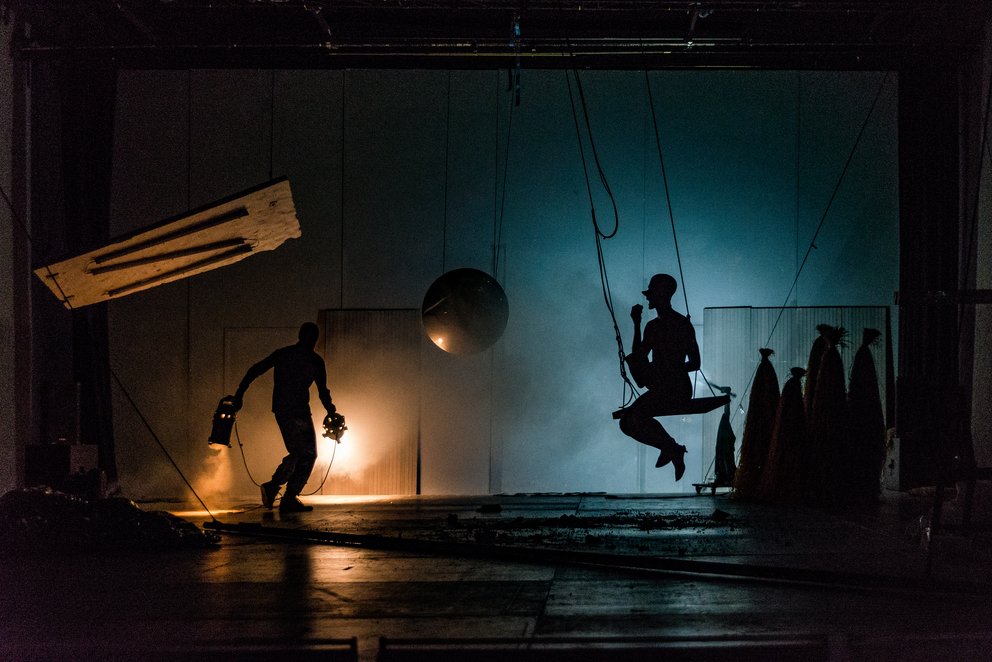
Laskaridis has chosen to adopt a totally burlesque tone, countering the gravity of his message with the frivolous treatment he gives it. With its over-the-top attitude and wet squib plot, “TITANS” is really about death, pain, solitude and the vanity of all human action. What makes his piece amazing is that it addresses these questions by giving equal emphasis to the futility of ordinary acts like watering flowers, riding a swing and sweeping, and the absurdity of existence, of comparing the human lifespan to the temporality of the stars, producing a joyous paradox that the characters exacerbate rather than resolve.
The choreography works along with the dramaturgy in creating this Ubuesque alliance of the trivial and metaphysical. The motif of rotation, a term that describes our daily routine as well as the movement of the planets, organizes the meeting of the two: the rocking chair in “Relic” becomes a swing, and this oscillating movement intensifies the already throbbing atmosphere. Hesitations, useless and superficial gestures and mispositioning constitute the physical vocabulary of this tragicomedy lacking any stable linear progression or clear narrative logic. In this literally nonsensical tableau, Laskaridis gives us a tender and even loving picture of the contradictions of a humanity lost between immortality and consciousness of its finitude, turning the makeshift lives and misfortunes of his characters into titanic symbols of the human condition.
This article was initially published in October 2017 within artpress magazine in the frame of “New Settings”, a programme by Fondation d´entreprise Hermès.
Translated from French by L-S. Torgoff.
